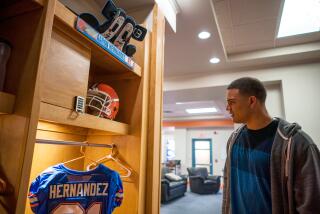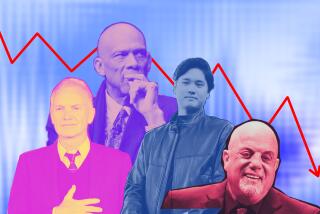âPublic Heroes, Private Felonsâ
When the Boston Red Sox released him after the final game of the season, Wilfredo Cordero expressed his joy at being a free agent.
âIâm happy,â he said. âI get to go home to my family--me, my wife, the baby--and enjoy my life.â
Heartwarming.
The only problem is that police summoned to his home last June 11 said they found his wife bruised and bleeding and Cordero threatening to kill her.
This was not so heartwarming and led to an arrest on a number of charges including assault and battery and violating a restraining order. The trial is set for Oct. 20.
Cordero thus became a member of a growing fraternity--athletes charged with violence against women. They are the subject of Jeff Benedictâs new book, âPublic Heroes, Private Felons,â an examination of how stars cheered on the field often turn into savages off it.
The condition borders on an epidemic with charges reported almost daily. Benedict wonders about what causes the flood of cases and what happens to the athletes after they are reported.
âBy and large, they get off,â he said. âLook at the disposition of the cases. Theyâre very rarely prosecuted successfully. Sentences are often minimal. The courts are hamstrung by plea bargains because of the difficulty getting the initial charges to stick.â
Benedictâs book, which grew out of research he conducted while on staff at Northeastern Universityâs Center for the Study of Sport in Society, details many well-known cases. He says the blame for this aberrant behavior needs to be shared, particularly when it happens at the collegiate level.
âItâs coaches who recruit players who are at risk,â he said. âThey know from past behavior and experience what to expect. In fairness to the recruits, many are from less than perfect environments, exposed to violence and crime. If they want to offer them scholarships, thatâs OK. But they have a duty to do more than just put them on the field. The message is, âAs long as Iâm good enough, I can come in and play.â
âItâs often inappropriate to offer scholarships to these players. They choose to bring them to campus and push them through the system for three or four years. Lawrence Phillips is the perfect example.â
Phillips is the St. Louis Ramsâ running back recruited by Nebraska after a troubled childhood growing up in a group home in West Covina, Calif. The âat-risk â signals were there from the start. In his third year in college, Phillips pleaded no contest to misdemeanor assault and trespassing in the beating of his ex-girlfriend.
Nebraska coach Tom Osborne responded with a six-week suspension, then allowed him to return to the team in time for the national championship game, explaining that Phillips needed the structured environment of the team. The day after Nebraska won the championship, the coach recommended that Phillips turn pro and find somebody elseâs structured environment.
âThe problem was shoveled off to the Rams,â Benedict said. âPhillips got in trouble again and was arrested almost immediatelyâ on drunken driving charges.
So who is to blame? Osborne? The Rams? The system?
Consider last weekâs partial police blotter in sports.
Ohio State freshman wide receiver Ken-Yon Rambo was charged with drug abuse, disorderly conduct and resisting arrest. A day later, University of Miami freshman wide receiver Santana Moss was arrested following a fight at a bar and charged with battery on a police officer and resisting arrest.
âSports are big in America,â Benedict said. âSometimes, priorities get out of balance. The moral compass, too exposed to the limelight, can go awry and ethics get pushed aside.â
Thatâs distressing stuff.
There are hopeful signs, though. Teams have cut problem players. The Red Sox and Cordero are just the most recent example. Benedict thinks there will be others.
âWe need a little more backbone as spectators when we know we may be cheering for a rapist or some other felon,â he said. âFans are the great indicator to teams for whatâs tolerable. If an abuser returns to the field charged with a crime and is cheered, itâs a demonstration that people are not concerned.â
More to Read
Go beyond the scoreboard
Get the latest on L.A.'s teams in the daily Sports Report newsletter.
You may occasionally receive promotional content from the Los Angeles Times.










